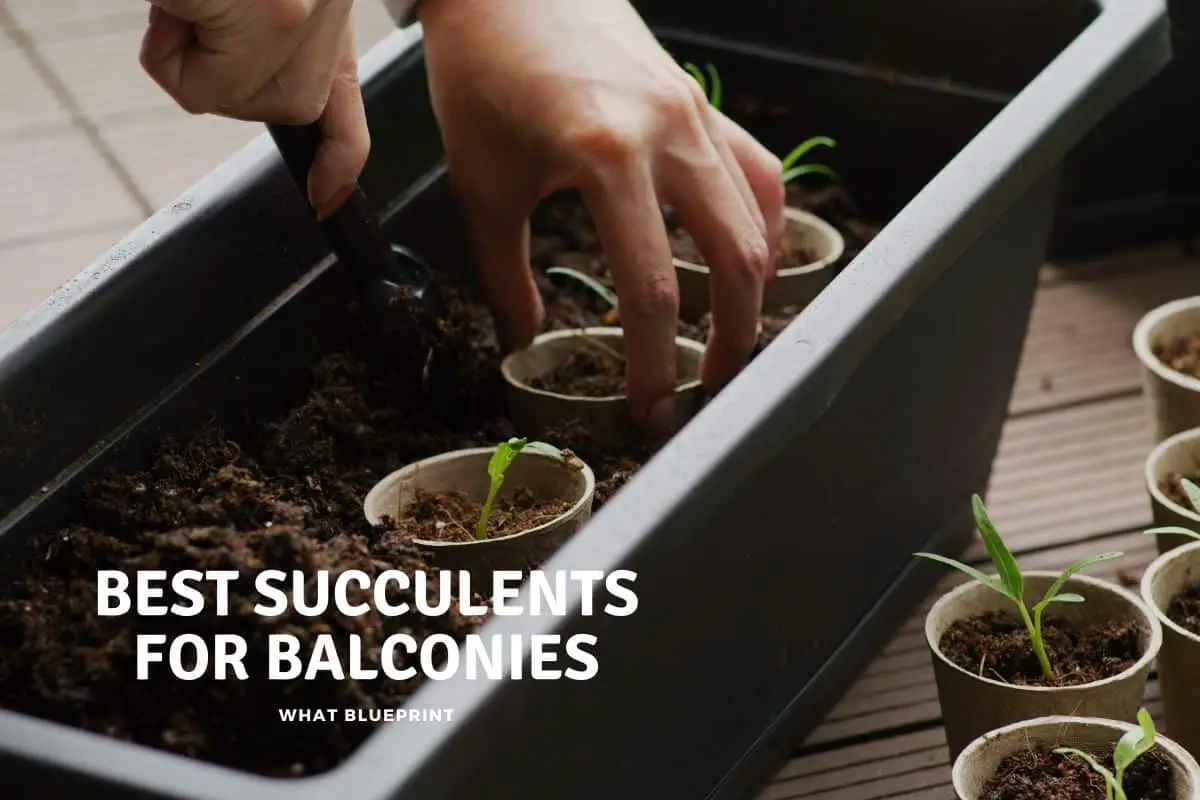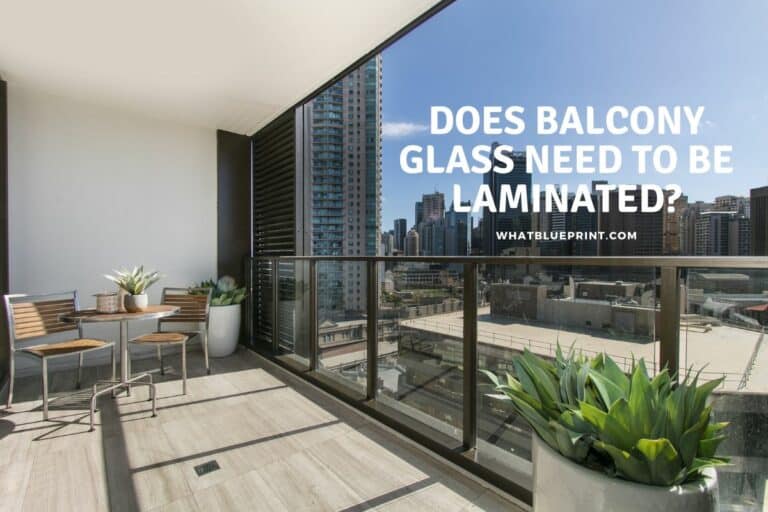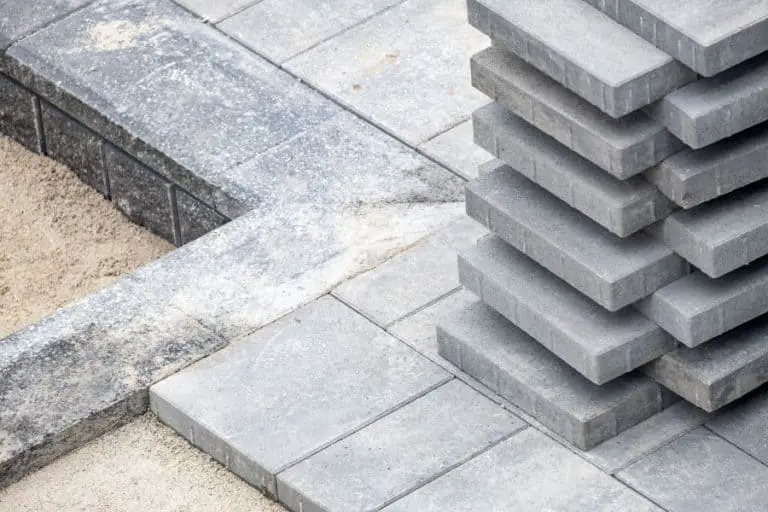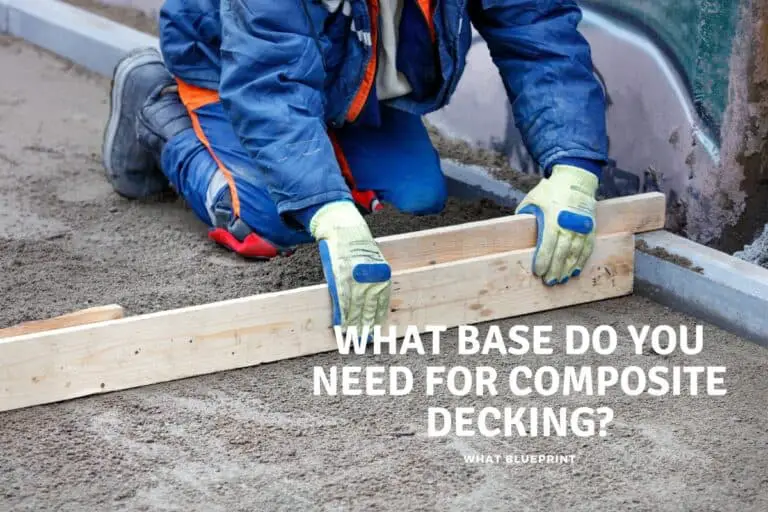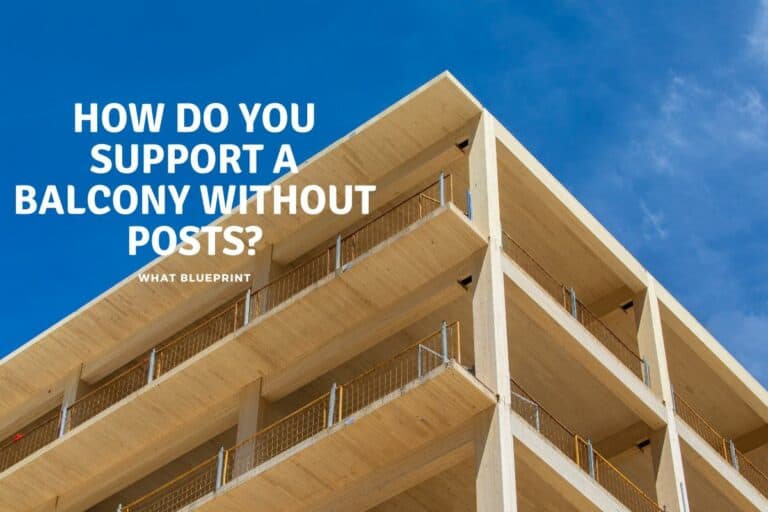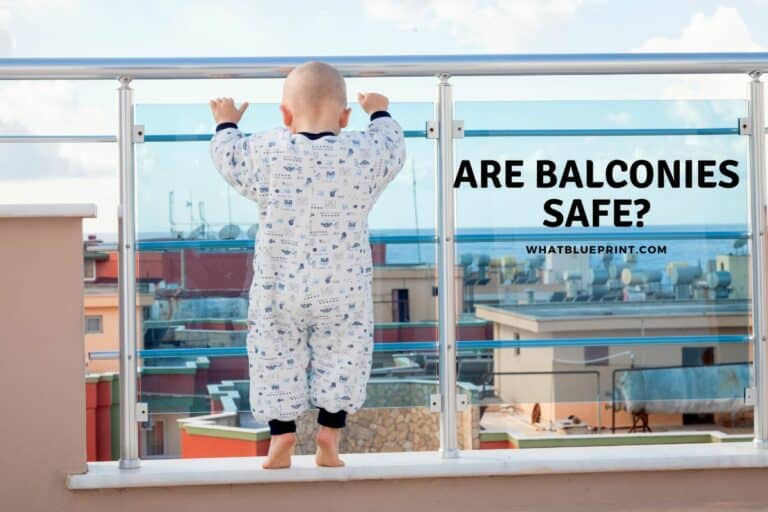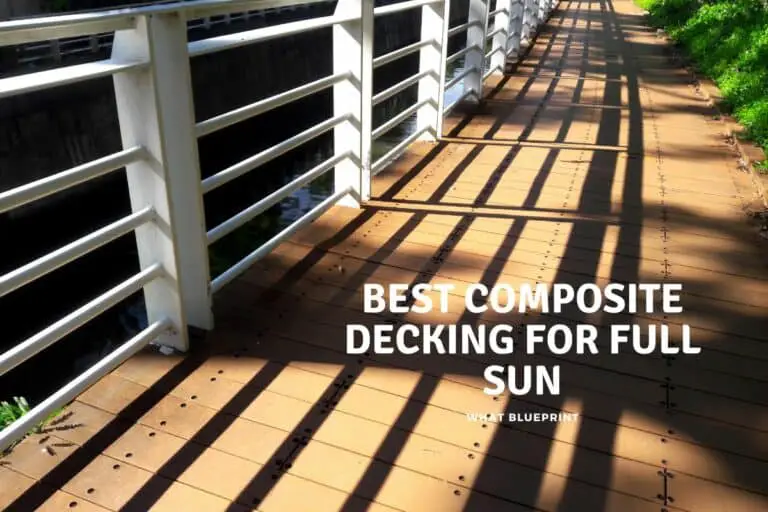Best Succulents For Balconies
Choosing furniture and accessories for a balcony can be tricky. Everything needs to be able to withstand the elements, and unless it is an extensive balcony, items need to be compact. Plants add a touch of life and make the balcony space feel more homely. Succulents are an excellent low-maintenance, hardy choice if you know what you select.
Eight of the best succulents for balconies and balcony settings:
- Snake Plant (Dracaena Trifasciata)
- Echeveria
- Hen and Chicks (Sempervivum)
- Aloe Vera
- Sedum (Commonly called Stonecrop)
- Jade Plant (Crassula ovata)
- Yucca Plant
- Christmas Cactus (Schlumbergera truncate)
Since most of us don’t have Buckingham Palace-sized balconies on our homes, everything needs to be carefully considered to make the most of the space. Adding a plant to any balcony is always a lovely touch. Unfortunately, not everyone has green fingers, and having a shriveled, weather-beaten specimen in your small space is what decorating disasters are made of.
The following succulents list generally doesn’t require much fuss and will enhance and compliment a balcony setting.
Best Succulents For Balcony
A balcony adds opulence to any space. Though the area may be small, being able to step outside on a warm day or enjoy a sundowner in the comfort of an elevated little perch always feels special.
‘Succulent’ is a term that covers many types of plants. The main characteristic is that the plant can store water. They are characteristically tough and able to cope in well-drained soil without needing regular fertilizer or loads of care.
For balcony gardeners, the appeal of succulents is that they are usually compact and neat in appearance. It is unlikely they will suddenly overgrow, and you will need to do loads of pruning to keep them looking good.
When choosing succulents for balconies, you need to keep a few things in mind. Even though they are a highly hardy group of plants and usually an excellent space for container gardening, like all plants, they do need the following basic survival conditions to be met:
- Temperature – Succulents are mostly adapted to survive in warm, arid conditions. If you live in an area of extreme temperatures, choose varieties that will be able to survive the big freeze in January. Check what plant hardiness zone you fall into before you go succulent shopping.
- Light – Not all balconies receive direct sunlight, and many succulents need a constant supply of direct sun to survive. The amount of light on your patio is a vital consideration if you want your plants to stay in tip-top condition. We will include a few varieties on our list that can cope without direct sunshine.
- Shape – Succulents can be tiny enough to stand in a pot on a small drink table, or you may want the plant to be a feature in a huge planter. When considering the size, keep safety in mind if you have young children. Some larger succulents have sharp spikey leaves that may be face height to a child.
- Toxicity – If you share your home with children or four-legged kids, you must ensure that your succulents are safe in case they are accidentally ingested. A popular plant that must be avoided entirely if you have kids is Euphorbia, commonly known as Firestick or Pencil cactus. It is easy to grow and beautiful but not ideal for small spaces where you may brush against it or kids may be tempted to break bits off.
- Size – Keep the size of the space, the container, and the potential size of the plant in mind. Although most succulents are slow growing and tend to stay compact, keep in mind that some varieties can get really tall and may start looking too large for the space.
Balconies are also typically situated on upper floors, so moving a massive, spikey plant like a Joshua Tree after a couple of years may not be as fun as it was when you planted it. However, it is still a great choice if you have an exposed balcony, so know the potential size your plant may become while choosing.
Now that we’ve covered the basics, let’s go through eight great choices of succulents that will complement your balcony space and the best succulents for balconies.
Eight Best Succulents To Grow On A Balcony
Whether you need a tiny plant with a hint of feng shui, or a dramatic-looking aloe, there are succulents for balconies to fit (and survive) every balcony setting. Though space may be limited, plenty of excellent options are available that don’t require you to be a master gardener.
1. Snake Plant (Dracaena trifasciata)
| US Plant Hardiness Zone | 9-11 (USDA) |
| Light requirements | Partial sun to shade may do well on a balcony that doesn’t receive full sun. |
| Soil | Well drained, sandy soil |
| Watering | Soil can dry out between waterings. Does not need a lot of care. |
| Toxicity | Toxic to dogs and cats |
| Size | Snake plant width will be limited by the pot it is in. If it has space, it can get tall. |
On top of the list of ideal succulents for balconies is the ever-popular Snake plant. This hardy succulent offers a textured appearance and can grow impressively tall in a large container, but it will never encroach on the limited floor space.
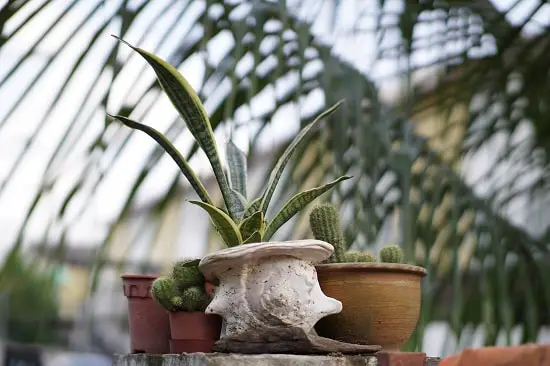
Long, dramatic-looking spears of stiff green and yellow leaves twist upward from the soil. Snake plants come in many varieties, although the Dracaena trifasciata is the best-known one. Snake plants are also amusingly called ‘Mother in Laws Tongue’ as the leaves have a distinctively sharp edge.
They can provide an interesting column-like look in any planter, and the underground rhizome will continuously shoot up more leaves.
2. Echeveria (Spp.)
| US Plant Hardiness Zone | 9-11 (USDA) |
| Light requirements | Full sun |
| Soil | Well-drained soil. It can be planted in a shallow pot. |
| Watering | Low watering requirements. |
| Toxicity | Completely non-toxic and safe |
| Size | Small, neat rosette sized |
If you prefer a small, neat, and tidy succulent that comes in plenty of varieties, Echeveria is perfect. Plants have thick, fleshy leaves arranged in gorgeous rosette shapes. Cluster a few together to form a low-maintenance, living flower arrangement in your balcony planter.
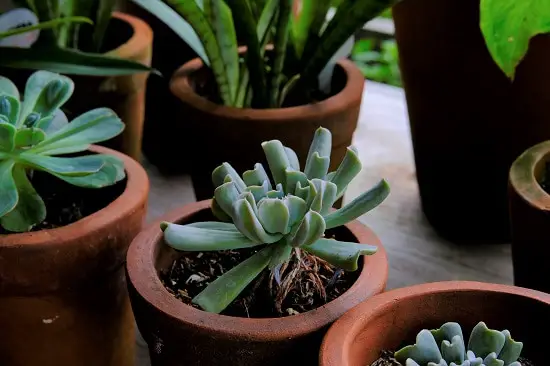
There are many mix-and-match Echeveria options, and clustering a bunch together can be an attractive feature on its own, or these small plants can be companion plants at the base of a larger feature plant. The only downside with Echeveria is that they are generally not frost-hardy and may also struggle during prolonged periods of rain as their roots are prone to root rot.
3. Hen and Chicks (Sempervivum)
| US Plant Hardiness Zone | 3b – 11 (USDA) Dependent on the variety. |
| Light requirements | Full sun |
| Soil | Well-drained soil. It can be planted in a shallow pot. |
| Watering | Low watering requirements. Drought tolerant. |
| Toxicity | Completely non-toxic and safe |
| Size | Small, compact, rosette-shaped plants |
Sempervivum is often confused with Echeveria, as they have similar low-growing rosette-shaped formations. While they also enjoy full sun, Sempervivum is a much better balcony option for anyone living in more extreme climates. Sempervivum can handle frost and thrive, even in the care of novice gardeners.
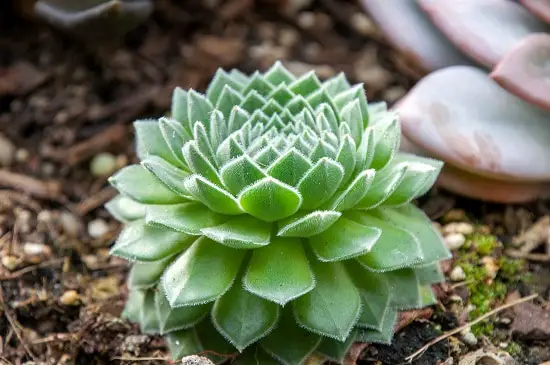
These hardy, no-fuss plants are monocarpic, which means that when a rosette dies, it will quickly be replaced with new offsets. Small offsets form during the growing season that can be separated and planted in new planters or left to create a fuller appearance in your balcony planter. This characteristic was the inspiration for the plant’s common name, Hen and Chicks. They are some of the most common succulents for balconies.
We also have articles on Tall, low maintenance and other balcony and porch plants on the site. You can access these from the list below.
4. Aloe Vera
| US Plant Hardiness Zone | 8 – 11 (USDA) |
| Light requirements | Full sun |
| Soil | Fast draining succulent mix |
| Watering | Low watering requirements. Drought tolerant. |
| Toxicity | Toxic to dogs and cats. The gel inside leaves can be used medicinally in humans, especially topically. |
| Size | Small- but can grow up to 3 ft. tall |
Aloe vera is one of the well-known varieties of these tough succulent plants. This variety has become popular as it is a medicinal plant used to treat a wide variety of skin conditions for thousands of years. They are a great hardy succulents for balconies plant.
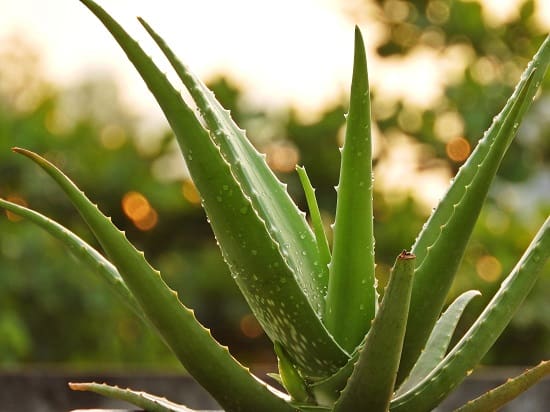
This aloe can provide dramatic visual appeal to a space. It has a short stem with long fleshy green leaves that radiate upward from the center. The plant thrives in outdoor containers and requires very little care to stay in excellent condition.
Any aloe can handle life in a container on a balcony, so long as it gets enough direct sunlight and doesn’t get too cold. Aloe vera is a good choice if you want a big, no-fuss plant that will never drop leaves.
5. Sedum (Commonly called Stonecrop)
| US Plant Hardiness Zone | 3 – 11 (USDA) |
| Light requirements | Full sun |
| Soil | Fast draining soil – can tolerate poor soil |
| Watering | Low watering requirements. It may rot if it gets too much water |
| Toxicity | Not toxic and edible |
| Size | A variety of species are available: Creeping, trailing, and tall. |
Sedums are not only one specific plant but cover a range of forms of varying colors and foliage. These succulents for balconies produce abundant flowers, which will attract butterflies and birds to your balcony.
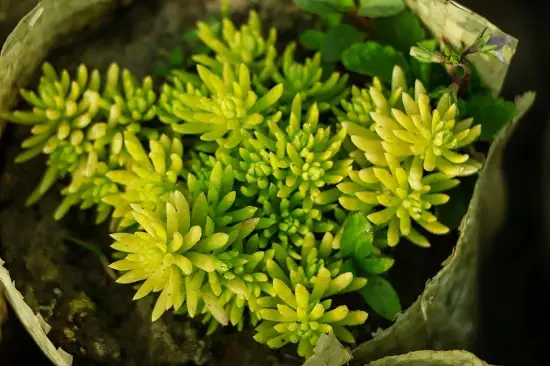
Stonecrop is especially attractive for balcony gardeners because although they can cope with harsh weather conditions and plenty of sun, many varieties are also extremely cold tolerant.
A little-known additional benefit to growing these hardy little plants on your balcony is that many varieties are edible. The leaves can be eaten raw or in stir-fries and impart a slightly peppery taste. A truly perfect succulents for balconies plant that ticks all the boxes.
6. Jade Plant (Crassula ovata)
| US Plant Hardiness Zone | 10 -12 (USDA) |
| Light requirements | Full sun |
| Soil | Well-draining soil mix |
| Watering | Drought and pest resistant |
| Toxicity | Mildly toxic to humans if ingested. Toxic to dogs and cats. |
| Size | Slow growing and can stay small and compact if limited by the pot size. It can reach 6 feet in height. |
Jade plants are also frequently known as Money trees. They are a symbol of good luck and make great housewarming plants. What could be more perfect for your balcony?
Jade plants are very popular as balcony plants and don’t need much care to look good. They can survive in shade or bright sun, but the downside is that they are not tolerant of cold. If you live in a cooler state and want to keep a jade plant on your balcony, you must bring it indoors when temperatures fall below 50F.
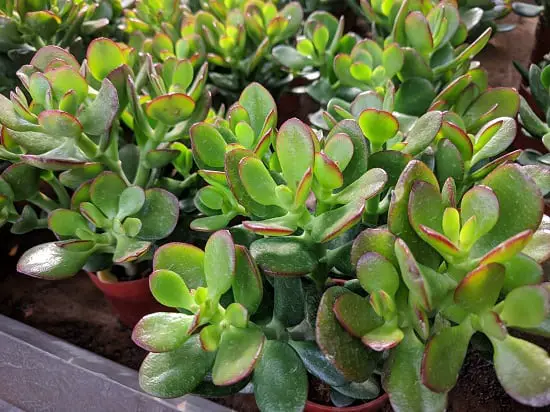
Young jade plants can be attractive small plants. They are excellent beginner plants, and like most succulents for balconies, they are more likely to die from too much water than too little. Although it is slow growing, jade can reach an impressive size, and they have a miniature tree-like appearance.
7. Yucca
| US Plant Hardiness Zone | 3 – 10 (USDA) |
| Light requirements | Full sun |
| Soil | Can tolerate poor, dry soils |
| Watering | Drought and pest resistant |
| Toxicity | Not toxic to humans, but leaves are needle sharp and can cause injury. Toxic to pets. |
| Size | 24 inches up to 30 feet |
Love them or hate them, Yucca plants are survivors that can reach impressive sizes even if they don’t have ideal conditions. They add a dramatic element to your outdoor space and are often placed in pairs on either end of a balcony to frame the space between. This makes them ideal for exposed balconies where they may be a lot of wind and harsh sunlight.
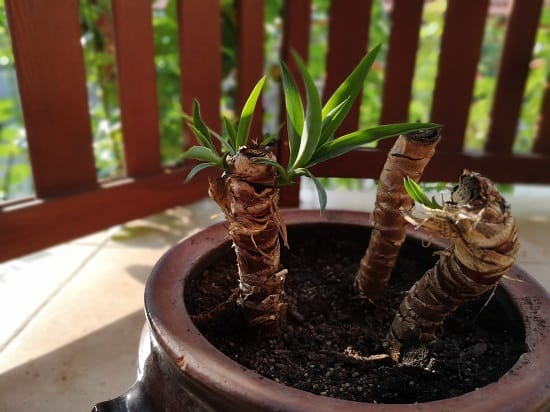
Yucca is a general term that encompasses more than 40 species and hybrids. They are also commonly called There is plenty of variety, and some are able to handle extreme conditions, right down to USDA zone 3.
The only two pitfalls of keeping one of these plants in a small space like a balcony are that most varieties have spikey leaves, which can cause injury if you collide with them. The other is that some yuccas can become impressively large. This is great if you need to create a green privacy screen on one side of your balcony, but it can be tricky to prune and move the plant.
8. Christmas Cactus (Schlumbergera truncate)
| US Plant Hardiness Zone | 10b – 12a (USDA) |
| Light requirements | Some bright light, but not constant |
| Soil | Needs good drainage |
| Watering | Need regular watering. A pebble tray under the pot is also helpful to raise the humidity around the plant. |
| Toxicity | Not toxic to humans or pets |
| Size | 6 inches to 1 ft – perfect for hanging baskets |
The last succulents for balconies on our list will add some color to your outdoor balcony setting. Christmas cactus is a gorgeous weeping variety that will add a lovely touch of color during the coldest parts of the year. If you have Christmas Cactus on your balcony, be sure that you bring it inside for a few months when the temperature is below 50F.
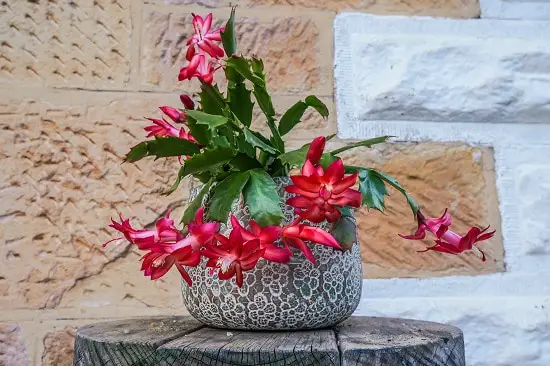
These gorgeous tropical succulents will delight you with their bright flowers. Just ensure that the plant does not get scorched in the sun. Hang the basket in a position that will also be in partial shade for most of the day.
We have loads of information and articles on plants for outdoor spaces, while a search will help checking out the articles linked below is also a good way to start.
- Best potted plants for a shaded porch
- best succulents for balconies
- low maintenance plants for balconies
- 10 tall plants for balconies
- low maintenance plants for decks
- how to keep porch plants alive in winter
Conclusion
succulents for balconies are an excellent option for a balcony garden where conditions may not be suitable for fragile plants. There are plenty of excellent choices to complement the décor of every balcony. A dramatic-looking succulent or two can thrive and add a whole different element of coziness.
References:
- https://www.gardenersworld.com/how-to/grow-plants/how-to-grow-succulents/#
- https://www.homedit.com/what-is-the-difference-between-a-porch-balcony-verandapatio-and-deck/
- https://www.thespruce.com/yucca-brevifolia-joshua-tree-growing-guide-5210437
- https://www.provenwinners.com/learn/how-plant/sedum
- https://plantcaretoday.com/yucca-plant.html https://plants.ces.ncsu.edu/plants/schlumbergera-truncata/

